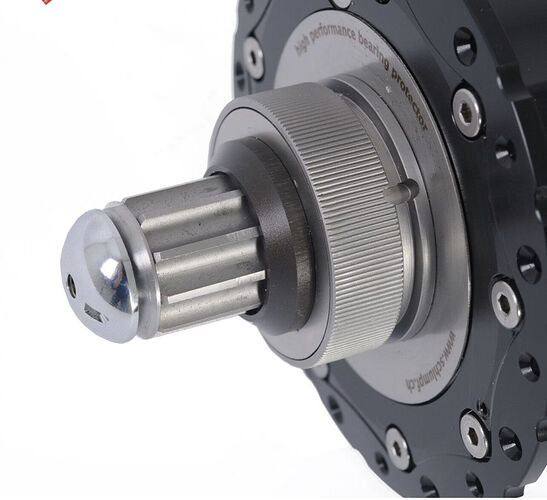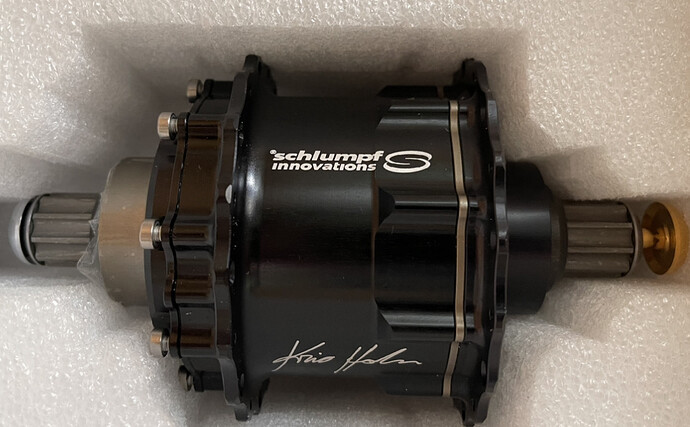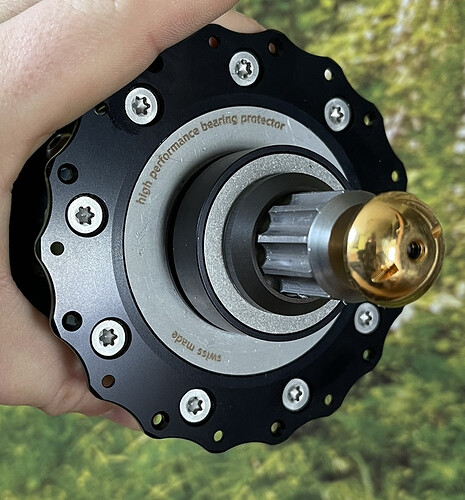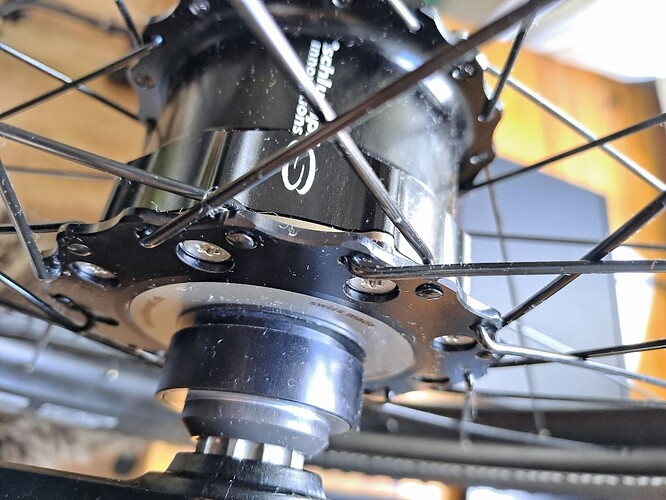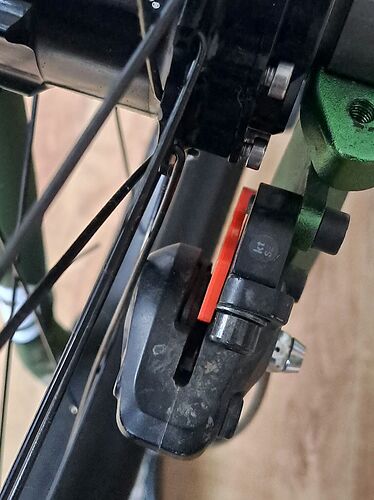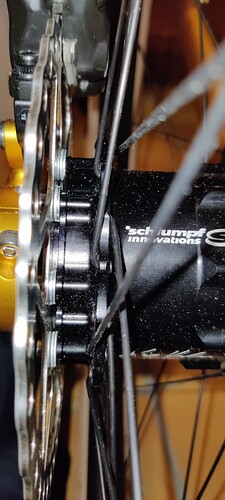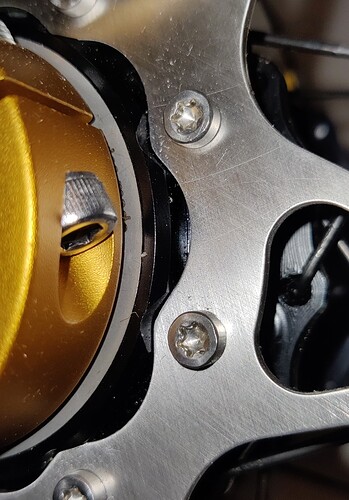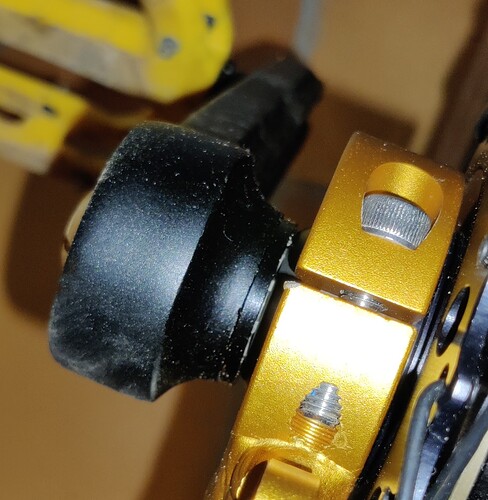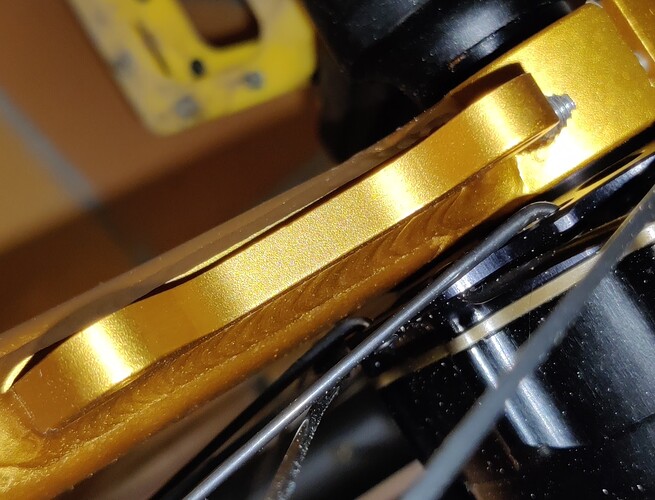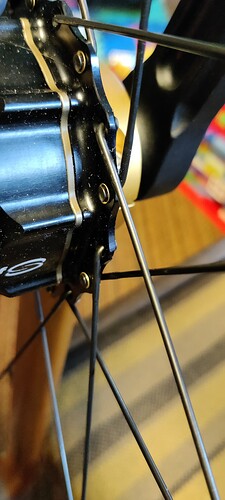I’d read it some months back, but only today went and looked at my 400 series hub that I laced 2 years back and realised Ive done it the wrong way! Those countersink are so inviting to put the spoke heads in and it looks so neat afterwards!
Now I need to decide if I’m going to rebuild the wheel - I’ve probably ridden it less than 500 miles…
Thanks for the finds John, & DrD!
They’re even more inviting when there are zero smaller countersunk holes on the off-holes. Meaning when you see holes that look like spoke head recesses, and holes that have nothing - you’re even more likely to think: ah ha, that’s when the heads must go!
Countersunk = counterintuitive ![]()
I had a bit of a deja-vu feeling about all of this, not from the Schlumpf perspective as I don’t have one, but from other hubs, remembering how much better the spoke seemed to sit when the bend was in a countersunk hole.
It is a bit surprising that there isn’t a countersink on each side of the flange. I’ve built a couple of wheels with Schmitt hub dynamos (look for pictures of SON hub dynamos, eg the SON 28) – they have pretty deep countersinks on the outside which are exacerbated a bit because of the inward curvature of the flange. I seem to remember thinking that the J of the spoke sat pretty well in those countersinks. On the spokes with the heads on the outside they sit pretty well in the deep countersink but there is a shallow countersink on the inside as well for the bend. I had a look at one of the wheels and the spokes do look like they sit well at both sides of the flange.
I also had a very quick look at my Pipfax hub, which is still unbuilt for various reasons, and it has a countersink on each side too. I had a quick look at a Hope Pro4 rear hub and it is a bit difficult to see because it is built up and has a cassette and disc on it, but there is a slight countersink, maybe more of a debur/relief on each side of it.
Putting spoke washers under the heads on the un-countersunk side of the Schlumpf. as suggested by your wheel builder, is really a bit like providing a countersink I suppose!
I totally agree this is strange as previous versions - or shall we say the last one has countersinks on each and every hole but the bigger ones are the ones according to that screenshot above, where spokes should for those hubs go.
Last version of the hub:
I note with these new hubs the flange for the disc side is thicker and I am going to say this is due to it taking greater tensions due to being asymmetrical.
I can only presume that Florian decided to only countersink alternating holes as not having a countersink for the spoke heads is either stronger, or having one there would be a a weakness again from the two differing spoke tensions for disc and non-disc sides.
Or I suppose there could be a third option and it is a mistake, but I’m inclined to trust Florian’s design approach.
Hubs of yesteryear seem to be of this new 2022 Schlumpf ilk, so it can be done (to countersink alternating holes)
I believe these new hubs also have their flanges out wider than previous generation so spoke clearance can/might be an issue. My thinking is that when built with spoke heads on a flat / non-recessed surface, this brings their outside protrusion at the J-bend to a minimum.
I’m really pleased to have settled on using washers. It may not be that common a practice but seeing those old posts above I can see people have opted for this with their Schlumpfs and in this case I simple don’t see it hurting anything.
Black hub, brass washers, silver CX Rays - pretty cool combo methinks when dropped into a raw silver frame ![]()
New wheel day should be Monday / Tuesday, and let’s keep fingers crossed there’s no major headaches fitting to frame or adding brake ![]()
![]()
I am uncertain if I put my spokes in the wrong way. How I put them in felt natural (head in the dent). This caused the spoke bent to look out too much on the other side and now they are rubbing at the brake. Also noticed that @mindbalance wheel was laced the other way.
Has anyone extra information how it should be?
I think this is the wrong way as the intuitive way would be to put spoke heads into the countersinks - but this does not appear to be how Florian previously intended.
It’s all explained here:
See the post directly and then expand the embedded posts - plus old PDF that explains how on older hubs the wrong way was cutting into the hub body.
You can see in my instagram how the wheel build looks when does the right way, plus with the use of washers
Edit: I should just add there’s a 1% chance that Florian comes to us with a new manual tomorrow or later this week which changes this all - but personally I would highly doubt this and find it pretty odd. It seems pretty clear that the countersinks are for the J-bend curve ![]()
Do you have a photo of this?
I definitely will take the wheel apart then and try it the other way
Mmmm this was something I kind of feared we might face. Not totally sure the other way of spoking the wheel will fix this - I always wonder if the hub was ever prototyped and tested or just designed to theoretically functioning.
Does the rotor fit and spin in the calliper correctly? I’ve been wondering about using washers to move the rotor out from the hub for that kind of alignment issues…
But for yours it could be helped by spoking the wheel the other way (we’ll call it the “right” way unless Florian corrects this!)
The next option would be to start seeing which brakes rub and which don’t and if it is close I’d be thinking of filing a bit of the metal off off the calliper body (but that would be a last resort!)
I haven’t tested the disc yet, but I am pretty sure that it doesn’t fit. But I definitely think with some spacers underneath the disc and longer bolts it will fit. We had this, but way worse one the first Freewheel Qu-Ax prototype and it was (partly) solvable and durable that way. It’s an older Shimano SLX brake on it.
Rotor diameter ? Larger rotor will help a lot
Yes, that definitely will! I ordered (unfortunately) a 180 mm one and the adapter used is alsoone for 180mm. For the Freewheel prototype we also used a 203 mm to solve the problem
With inboard disc and 100mm bearings distance I will only consider 203mm if I was Florian Schlumpf, no other option !
I can already feel the postal service becoming weighed down by customers returned 180 and below sized rotors… ![]()
![]()
Begs the question why those were an option if this kind of thing was a likely result.
Does anyone know if these a clear way to measure calipers?
Be nice to know which are the slimmest and which are the widest in terms of spoke-ward protrusion.
Totally agree. It is adding to the manufacturing complexity for what would seem like minimal purpose / gain, and in fact likely issues.
I have 203 and 180 rotors. Will test when I get my wheels with Hope Tech3 E4 brakes ![]()
I just build my Schlumpf uni yesterday and I did build with the spokes “the right way” (opposite of yours) - and with a 180mm disc it did rub the disc brake caliper. I tried both with Magura and some different (cheap) Shimano calipers. With a 1mm M4 spacer behind the disc (between disc and hub) a Shimano BR-MT420 could just barely clear the spoke. But with the slightest sideways force it would hit the spokes so I ended up using 2mm spacers between disc and hub. I think it will be just fine as the brake discs still slots into the hub so there is not really much force on the spacers/screws.
Btw I also filed a bit of the corner of the disc caliper just for some extra clearance.
I guess I should order a 203mm disc… or does anyone know of any really slim brake calipers?
I’ll share a few pictures / notes from my build as it may be of help for others.
Hub is 100mm 36h
Frame is a M4O size M.
EN933 light bicycle rim (29", 3mm offset)
I’m using Sapim Race (2.0-1.8-2.0) spokes on the disc side.
Disc is 180mm with 2x1mm M4 spacer between disc and hub (my caliper measured them at 0,8mm each so it’s probably closer to 1,5mm than 2mm spacers)
Caliper is a Shimano BR-MT420 (with the corner filed off for a bit more clearance).
Picture shows the very tight clearance between spoke and caliper. Likely ~1mm.
Spacers between disc and hub is also clearly visible.
In the picture its visible how the brake disc was made to slot into the hub. Seems like a very clever trick to make the force of the braking be transferred to the hub body, and not the screws (even with spacers).
As @Joris pointed out the cranks does not seem to go against the crank-stop/spacer on the hub. I experienced the same. I did a few quick measurements and it seems the interface is missing approximately 2mm of spacers to be similar to my other hubs.
I mounted 2,5mm spacers on mine and after using 42nm torque it still did not fully close the gap / using Nimbus Venture cranks as seen in below picture. I assume a bit more would close the gap but with no manual available yet I played it safe and stopped.
I’m using Sapim D-Light (2.0-1.65-2.0) spokes on the non-disc side.
The clearance between spokes and frame is almost non-existent. It’s less than 1mm.
If I have to rebuild the wheel someday I will add some spoke head washers to bring spoke closer to the flange (it shortens the j-bend).
Be aware that the flanges on the disc and non-disc side are very different thickness. One or two spoke head washers could probably be added without issues for the non-disc side but the disc sides has no room (or need) for those as the j-bend closely follows the flænge.
Edit: I added one spoke head washer on the non-disc side flange. Now there is ~1mm clearance to the frame and the spokes follows the flanges with no visual gap
Replying to my own thread hijack when I looked (briefly) at my hub and swa I had the spoke heads wrongly in the countersunk side of the flange hole…
… I now looked closer and see that there are countersinks on both sides of the holes on my hub (400 series). In fact looking it up on the Schlumpf hub history thread I see it was a feature introduced in that series:
KH/Schlumpf Generation 3
adding protection rings (external dust/water guards)
reinforced rim to avoid broken spoke holes
spoke holes countersunk on both sides
So that means definitely no hub rebuild needed - phew!
I wonder why Florian went back to only single side countersinks on this latest series, especially when some of the flanges are really wide.
Yes this is the odd and contradictory part about the whole business.
As previously shared here:
The manual snippet says that heads go into the bigger diameter countersink. But I am totally convinced that when it is alternating countersinking, then the spoke heads have to go on the flat side as the primary aim for the countersink is for the J-bend. And given the current likely fixable “disaster” regarding how close everything thing is for clearance - I also think spoking the wheel this way round (heads on the flat) helps give a wee bit extra space. And every 0.1mm counts!
As to why Florian went back to not countersinking every hole. This is firmly in the land of conjecture.
I know I’ve written my thinkings as to why this is the case somewhere in one of my rambling posts - but I can’t for the life of me find it. So I’ll summarise:
- Having the spoke heads go into countersunk holes makes little to no difference for strength of build - so then going on a flat surface as with hubs of yesteryear is a moot point
- On an asymmetrical build of this ilk countersinking the holes for the heads could lead to weaknesses in that area - so best not to do it
- It’s an oversight and complete mistake
- If they had been countersunk there would have been even worse non-clearance of spokes and caliper than we’re seeing currently - so Florian needed to skip this for them
My gut says it is in fact a mixture of 1 + 4. I think the heads going into a flat hole makes their attachment strong and secure and actually allows for the use of washers more easily. And I do wonder if Florian has been hunting for every millimetre of space probably both internally and within the constraints of the hub body… so perhaps there’s awareness that doing things this way helps set things up for as snug and close spoke lines as humanly possible.
Incidentally I’ve looked at my 200 series and I can see it was built the bad way round - so I’ve another Schlumpf project to fix one day with that beast.
My brain is basically reeling, wheeling and down right befuddled by all of this - but I’m still in the zone trying to enjoy the pain of problem solving and fishing for insight into the mysterious world of Schlumpf’s innovations ![]()
![]()
![]()
I was doing a bit of calculations. I wanted to figure out if upgrading from a 180mm to a 203mm would make it possible for me to remove the spacers I added.
I’m using the initial drawing from Florian as reference (I did not verify if the final hub is any different)
From middle of left bearing to left flange
E:16+D:17mm = 33mm
Left flange to middle of rim
100mm/2-33mm = 17mm
Note the measurements D+E is to the outside of the left flange.
So let’s add 1mm (even a thin/blade spoke has 2mm thickness at the flange) because we are measuring from middle of the spoke at left flange to middle of spoke at rim
17m + 1mm = 18mm “left-right distance" for the length of the spoke
Using 270mm spokes (likely typical for a 29" wheel build).
Going from 180mm to 203mm disc adds (203-180)/2=11,5mm to the radius.
18mm/270mm*11,5 = 0,77mm added clearance from using a 203mm disc compared to a 180mm
(18mm+3mm)/270mm*11,5 = 0,89mm added clearance from using a 203mm disc and a 3mm offset rim
Personally I’m using a 3mm offset rim but the 0,9mm will only make it possible for me to skip one of the spacers. Maybe grinding a bit more off the corner of the brake caliper would then do the trick. But it seems to me that even a 203mm disc does not make it an easy build without spacers. Or at least the brake caliper choice will be limited (assuming slimmer brake calipers even exists…)
Did I miss anything or are my calculations wrong?
